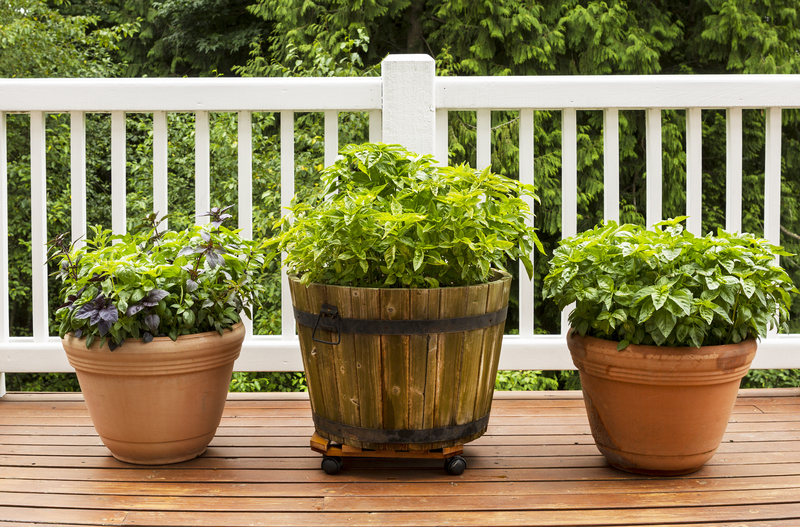From Soil to Sky: How Gardening Affects Climate Change
Posted on 13/06/2025
From Soil to Sky: How Gardening Affects Climate Change
Gardening is often associated with the tranquility of planting seeds, watching flowers bloom, and enjoying the abundant harvest. But the significance of gardening extends far beyond beautifying your surroundings or growing food. Today, gardens are increasingly recognized as crucial allies in the fight against climate change. From the soil beneath our feet to the gases that fill our atmosphere, every gardening decision connects to the bigger environmental picture. In this comprehensive guide, we'll explore how gardening impacts climate change and detail actionable steps anyone can take to grow a sustainable garden for a healthier planet.
The Global Challenge: Understanding Climate Change
Climate change is driven primarily by an increase in greenhouse gases--mainly carbon dioxide (CO2), methane (CH4), and nitrous oxide (N2O)--in the atmosphere. Human activities like burning fossil fuels, deforestation, and industrial farming are the main contributors. While the conversation often centers on large-scale interventions, small steps in our backyards can make a significant difference in sequestrating carbon, enhancing biodiversity, and fostering ecosystem resilience.
How Gardening Relates to Climate Change
- Carbon Sequestration: Plants and healthy soils store atmospheric carbon, helping reduce greenhouse gases.
- Biodiversity Support: Gardens provide habitat for pollinators, birds, and beneficial insects that stabilize ecosystems.
- Improved Air Quality: Vegetation absorbs carbon dioxide and releases oxygen, cleaning the air we breathe.
- Water Management: Gardens with native plants and organic matter improve soil water retention and reduce runoff.
- Urban Cooling: Trees and plants lower temperatures in urban areas by providing shade and facilitating evapotranspiration.

The Soil Connection: Underground Allies Against Global Warming
It's easy to overlook the critical role of soil in the climate equation. Soil is one of Earth's largest carbon stores--containing at least three times more carbon than the atmosphere. Healthy, living soil teems with microorganisms, fungi, and organic matter that capture and stabilize carbon in complex forms.
Ways Gardening Improves Soil for Climate Change Mitigation
- Composting: By composting kitchen scraps and yard waste, gardeners convert organic material into nutrient-rich humus, feeding soil microbes that lock carbon in the earth.
- Reduced Tillage: Minimal soil disturbance helps preserve soil structure and organic matter, preventing soil erosion and carbon loss.
- Cover Cropping: Planting cover crops during off-seasons reduces erosion, boosts organic content, and encourages deep-rooted plants to sequester more carbon below ground.
- Mulching: Organic mulch moderates soil temperature, preserves moisture, and adds biomass as it decomposes, all aiding carbon storage.
The Science of Carbon Sequestration in Gardens
Plants absorb CO2 during photosynthesis, transforming it into sugars and organic compounds. While some of this carbon is released back into the atmosphere, a portion remains as root biomass and decaying leaves. When gardeners cultivate perennial plants like fruit trees or shrubs, or use practices like no-dig gardening, they enhance the soil's ability to trap and hold carbon over time.
Eco-friendly Gardening Practices to Combat Climate Change
The impact of gardening on climate change isn't just about what you plant, but how you garden. Adopting eco-friendly approaches reduces greenhouse gas emissions and fosters more resilient landscapes.
1. Choose Native and Climate-Adapted Plants
Native species thrive in local environments, requiring less water, fertilizer, and chemical pesticides. This means they have a lower carbon footprint. Native plants also support local pollinators and wildlife, boosting ecosystem health.
- Select drought-resistant plants to save water and energy.
- Group plants with similar needs to increase efficiency.
- Prioritize perennial over annual plants for long-term carbon storage.
2. Go Organic: Ditch Synthetic Chemicals
Conventional fertilizers, herbicides, and pesticides require significant energy to produce and release nitrous oxide--a potent greenhouse gas--when applied to soil. Switching to organic methods, using compost and natural pest controls, reduces emissions and enriches the soil's carbon sink.
- Use compost, manure, or worm castings instead of synthetic fertilizers.
- Plant companion species that deter pests naturally.
- Encourage beneficial insects and birds to help with pest management.
3. Reduce, Reuse, and Recycle in the Garden
Every plastic pot, bag of soil, and garden structure comes with its own carbon footprint. Use recycled, repurposed, or biodegradable materials whenever possible.
- Repurpose old containers for planters or compost bins.
- Opt for wooden, stone, or recycled composite materials for garden beds.
- Collect rainwater in barrels to reduce dependence on municipal water systems.
4. Plant a Tree--Nature's Climate Champions
Trees are unmatched in their ability to absorb and store atmospheric carbon. According to estimates, a single mature tree can absorb around 22 kg (48 lbs) of CO2 per year. In addition to acting as carbon sinks, trees cool the environment, provide habitat, and even improve mental well-being.
- Plant shade trees on the south and west sides of your home to lower cooling costs.
- Choose native species to ensure long-term health and resilience.
- Care for your trees year-round to maximize growth and carbon capture.
5. Encourage Biodiversity for Resilient Gardens
Biodiversity is the backbone of a healthy ecosystem and resilient garden. Diverse gardens are more resistant to pests, diseases, and weather extremes--mitigating climate vulnerabilities.
- Integrate pollinator-friendly plants like wildflowers, herbs, and flowering shrubs.
- Create layers using ground covers, shrubs, and trees to mimic natural habitats.
- Build insect hotels or leave brush piles to provide shelter for beneficial bugs and wildlife.
Reducing Carbon Footprint Through Garden Choices
The Hidden Impact of Food Miles
Growing your own fruit and vegetables can significantly cut the carbon emissions associated with transporting food long distances (often referred to as "food miles"). By harvesting produce from your backyard, you support local sustainability and reduce reliance on fossil fuels.
- Plan a kitchen garden with leafy greens, root vegetables, and herbs.
- Join community gardening projects or support local farmers' markets for produce you can't grow yourself.
- Preserve excess harvest (canning, pickling, freezing) to extend the benefits year-round.
Lawn Alternatives for Lower Emissions
Maintaining a traditional turf lawn often involves frequent mowing (using gasoline-powered tools), watering, and fertilizing--all of which contribute to greenhouse gas emissions. Replacing or reducing the size of your lawn with wildflower meadows, native grasses, or ground covers conserves resources and sequesters more carbon.
- Plant clover or low-growing native ground covers that require minimal mowing and watering.
- Convert part of your yard to a pollinator garden for a balance between beauty and biodiversity.
- Use electric or manual tools when maintenance is necessary, further reducing your carbon footprint.
Community Gardening and Urban Greening
Individual gardens are powerful, but when communities come together, the impact multiplies. Urban gardens, rooftop vegetable plots, and community orchards play a crucial role in offsetting the urban heat island effect, promoting food security, and acting as local climate buffers.
Benefits of Community Gardening Initiatives
- Enhances local air and soil quality.
- Strengthens social ties and collective environmental stewardship.
- Connects people to nature, encouraging sustainable habits beyond the garden itself.
- Revitalizes unused public spaces and increases property values.
Urban Trees and Green Spaces
Planting and protecting urban trees can lower city temperatures, reduce pollution, and absorb stormwater. By participating in local tree-planting efforts or advocating for green infrastructure, citizens can help cities become more climate-resilient.
- Join tree-planting volunteer days in your neighborhood.
- Support local policies that invest in parks, gardens, and green corridors.
Gardening as Climate Education and Advocacy
Gardening offers hands-on lessons about the natural world, resource cycles, and our interdependence with the environment. Each garden--big or small--can become a living classroom, inspiring climate awareness and action.
- Teach children to compost, plant, and care for living things--skills that nurture environmental stewardship for life.
- Share resources and seeds with neighbors to expand the positive impact.
- Advocate through social media, blogs, or local events, demonstrating that climate solutions can start at home.
Challenges and Limitations
While gardening for climate change mitigation holds immense promise, it is not without challenges. Some areas face water scarcity or contaminated soils; others have limited space or community support. Furthermore, garden-based efforts must be part of a broader, systemic shift towards sustainability--alongside renewable energy, conservation, and policy change.
How to Address Common Barriers
- Start small, even with a few containers on a balcony.
- Use rainwater harvesting and drought-tolerant plants in dry regions.
- Seek out local gardening groups for knowledge, resources, and support.
- Test and amend soil if contamination is suspected, or opt for raised beds with imported clean soil.
The Future of Climate-Smart Gardening
Climate change is a collective challenge, but the gardens of today are the climate solutions of tomorrow. Innovations like vertical gardening, green roofs, permaculture, and regenerative agriculture offer blueprints for integrating carbon capture and sustainability into food production and urban design.
As the world adapts to new environmental conditions, the role of the gardener evolves from hobbyist to climate steward. Each seed sown, tree planted, and compost pile built is a direct investment in reversing global warming trends and cultivating a more resilient, greener planet.

Action Steps: How You Can Make an Impact
- Audit your current gardening practices, looking for areas to reduce waste, energy use, and chemicals.
- Educate yourself and others about nature-based climate solutions.
- Plant more trees, focusing on native or climate-adapted species.
- Compost all green and brown waste, returning nutrients and carbon to the soil.
- Embrace biodiversity, growing a variety of plants and creating wildlife-friendly habitats.
- Support regenerative community initiatives, from local gardening clubs to public green spaces.
Conclusion: Every Garden Counts in the Climate Fight
From the soil beneath our feet to the sky above, gardens wield remarkable power in the quest to reduce the impacts of climate change. By adopting eco-friendly gardening practices, nurturing healthy soils, and building vibrant ecosystems, every gardener can become an agent of positive change. Whether you grow a single tomato plant or oversee a sprawling wildlife habitat, your actions ripple outward, helping shape a sustainable, climate-resilient future for all.
Frequently Asked Questions About Gardening & Climate Change
- Q: Can small home gardens really impact climate change?
A: Yes! When scaled up across communities, small actions like composting, planting trees, and reducing lawn space make a measurable difference. - Q: Which plants are best for absorbing carbon dioxide?
A: Fast-growing, long-lived trees, perennial shrubs, and deep-rooted native plants are among the best options. - Q: How much carbon can be captured in my garden?
A: It depends on soil health, plant types, and gardening methods--but healthy organic soils and diverse planting increase carbon capture significantly. - Q: Is organic gardening better for the climate?
A: Organic gardening avoids high-emission synthetic chemicals and builds fertile soils--both important steps for climate mitigation.
Start your journey from soil to sky--each garden is a step toward climate hope.

